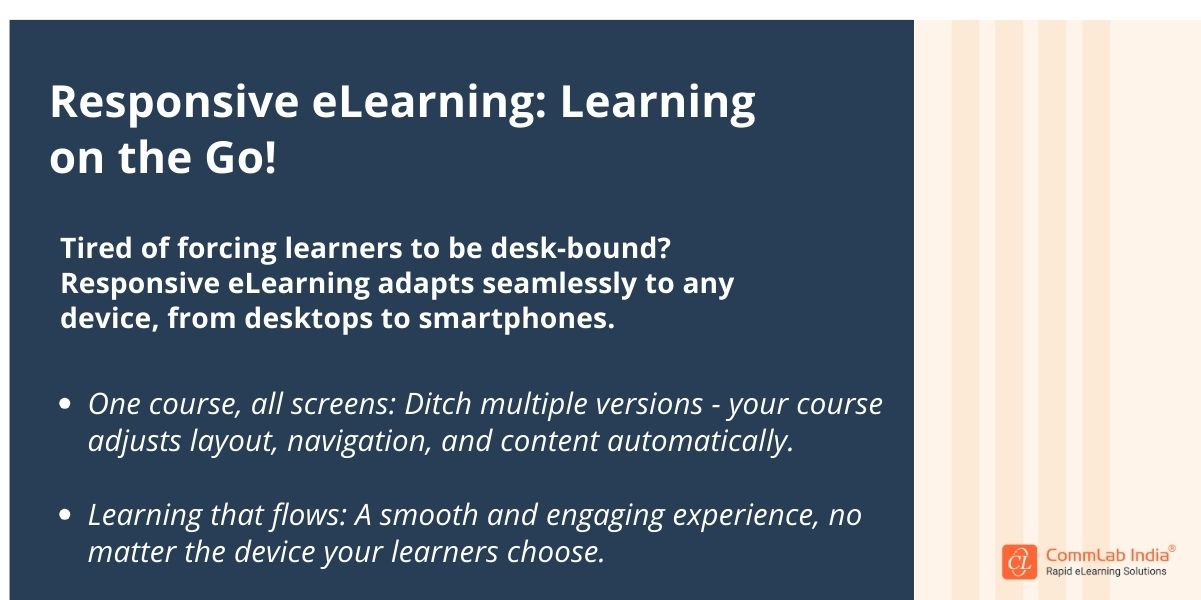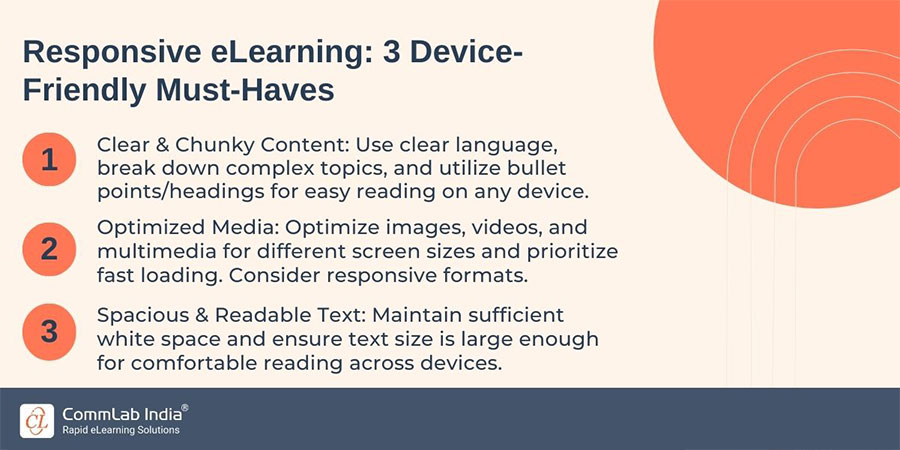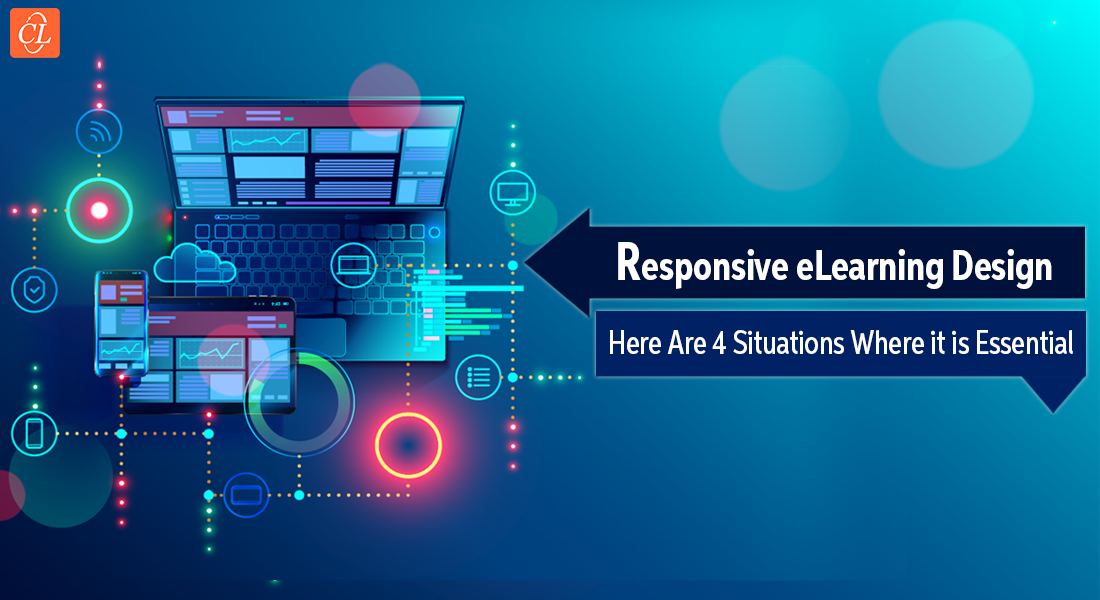How to Craft Responsive Corporate eLearning Courses? [Tips to Success]
![How to Craft Responsive Corporate eLearning Courses? [Tips to Success] How to Craft Responsive Corporate eLearning Courses? [Tips to Success]](https://blog.commlabindia.com/hubfs/blogs/responsive-elearning-design-tips-corporate-training-courses.jpg)
Today's rapidly evolving learning landscape places accessibility and inclusivity on the aisle. Learners come from diverse backgrounds and possess different learning preferences and device usage habits. To ensure everyone has an equal opportunity to acquire knowledge and skills, responsive eLearning design is no longer an option, but a necessity.
What is Responsive eLearning Design?
Picture this: Your eLearning course flawlessly adapts to any device, from desktops to smartphones. That's responsive design in action!
One course fits all: No need for multiple versions - this design automatically adjusts to different screen sizes and devices.
Inclusive learning: Everyone can access your training, regardless of their device, fostering accessibility and engagement.
Seamless experience: Learners enjoy a smooth journey, leading to better training outcomes.
Why is Responsive eLearning Design Important?
The benefits of adopting responsive eLearning design are numerous, impacting both learners and instructors:
For Learners:
Improved accessibility: Responsive design removes barriers for learners with disabilities by ensuring proper use of alt text, color contrast, and touch-friendly navigation, allowing them to access and engage with the course content effectively.
Enhanced convenience: Learners can access their courses anytime, anywhere, on their preferred devices, fostering greater flexibility and self-directed learning.
Elevated learning experience: A well-designed responsive course provides a consistent and visually engaging learning experience that can be accessed on different screen sizes, contributing to increased learner engagement and satisfaction.
For Instructors:
Reduced development costs: By building one responsive course instead of multiple device-specific versions, instructors can significantly cut down the required time and resources.
Wider reach: Responsive design expands the potential audience for eLearning courses, making them accessible to learners on various devices. This ultimately leads to wider adoption and potential cost savings.
Improved learner engagement: A good user experience (UX) across devices leads to higher learner engagement, ultimately enhancing knowledge retention and training ROI (Return on Investment).

How to Design Effective Responsive eLearning Courses?
Designing responsive eLearning courses requires careful consideration of various factors to ensure positive UX across different devices.
Let us now discuss some key aspects to focus on when developing responsive eLearning courses:
1. Content and Layout
Content clarity and organization: Use clear and concise language, break down complex information into smaller chunks, and utilize bullet points, numbered lists, and headings to enhance readability.
Visuals and multimedia: Optimize images, videos, and other multimedia elements for different screen sizes and ensure they load quickly even on slower connections. Leverage responsive image formats and consider using responsive video players.
White space and text size: Maintain sufficient white space to avoid clutter and ensure text size is large enough to be easily readable on all devices.

2. Navigation
Simple and intuitive design: Design an intuitive navigation system that adjusts (at fits well) to different screen sizes. Consider using consistent navigation elements like menus, tabs, and breadcrumbs, ensuring easy access to all course sections irrespective of the device.
Touch interaction optimization: If your course is likely to be accessed on touch devices, optimize buttons, links, and other interactive elements for touch interaction, ensuring they are large enough and spaced appropriately for easy taps.
3. Accessibility
Accessibility best practices: Follow accessibility best practices such as providing alternative text descriptions for images, using proper color contrast, and ensuring keyboard accessibility for navigation and interactions.
Accessibility checkers: Utilize built-in accessibility checkers often available in authoring tools or online tools to identify and address potential accessibility issues.
4. Testing and Optimization
Cross-device testing: Make sure that you test your responsive eLearning course across different devices with different screen sizes, operating systems, and browsers. This ensures the course functions as intended and the user experience is optimal across all platforms.
Iterative improvement: Use feedback from learners and testing results to continually refine and improve the responsiveness of your eLearning courses.
→ Download eBook: Rapid eLearning Design
Additional Tips for Engaging and Impactful Responsive eLearning Courses
Incorporate interactive elements: Utilize interactive elements like quizzes, polls, drag-and-drop activities, and gamification elements to enhance learner engagement and knowledge retention.
Consider microlearning: Break down complex topics into smaller, bite-sized learning modules that can be easily accessed and completed on any device. This facilitates self-paced learning and caters to learners with shorter attention spans.
Integrate learner feedback mechanisms: Include surveys, polls, or open-ended questions within the course to gather learner feedback and identify areas for improvement. This allows you to refine your courses and ensure they continue to meet learners' needs.
Maintain consistent branding: Ensure your eLearning courses maintain a consistent brand identity across various devices. This reinforces recognition and professionalism and creates a cohesive learning experience.
Microlearning: Ideal for Just-in-Time Learning with 4 Features! [Video]
Responsive eLearning Design: Choosing the Right Tools and Resources
Several authoring tools and resources can simplify the development of responsive eLearning courses. Many modern authoring tools offer built-in responsive design functionalities, allowing you to create courses that adapt automatically to different screen sizes. Additionally, numerous online resources such as tutorials, articles, and eLearning communities focused on responsive design can provide valuable guidance and support throughout the development process.
Embrace Responsive eLearning Design: Investing in the Future of Learning
By embracing responsive eLearning design, you can create inclusive, engaging, and effective learning experiences that cater to the diverse needs of your learners in today's mobile-first world. This ensures everyone has the opportunity to learn and grow, regardless of their device of choice. Responsive design ultimately promotes learner accessibility, increases training ROI, and paves the way for a more inclusive and successful learning environment for everyone.
Ready to craft engaging eLearning courses quickly? Download our free eBook on rapid eLearning design and discover how to use modern tools and techniques to create impactful training for your team.





